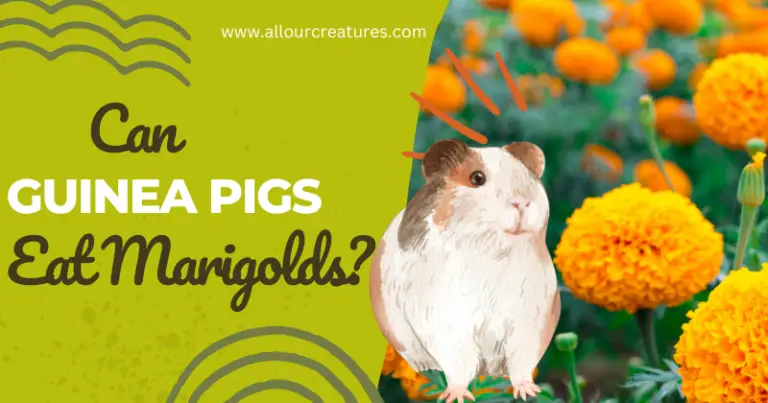How Do Guinea Pigs Play With Each Other: Fun Explained

As social animals, Guinea pigs have unique ways of interacting and playing with each other. Understanding the dynamics of their playtime and how guinea pigs play with each other is essential for guinea pig owners to ensure a harmonious and enriching environment for their furry companions.

In this article, we will explore the various aspects of guinea pig interaction, including bonding processes, the role of separate cages, and the significance of neutral territory. We will also discuss common behaviors exhibited during play and how to identify signs of aggression.
Whether you have a single guinea pig or a pair, this guide will provide valuable insights into fostering a positive play experience for your guinea pigs.
Contents
Table of Contents
How Do Guinea Pigs Play With Each Other: Ultimate Guide
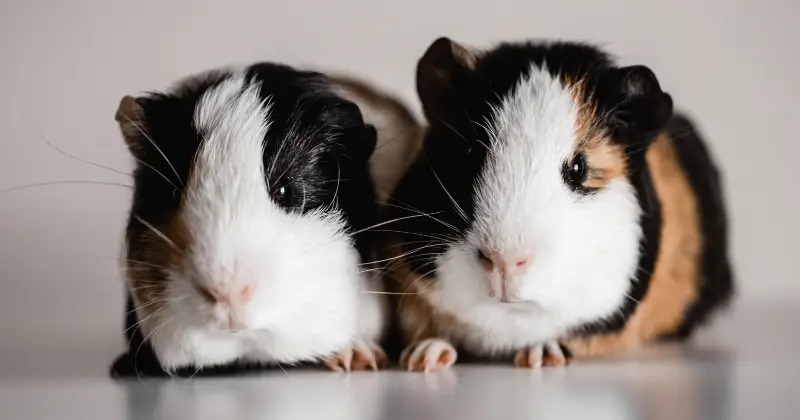
Guinea pigs are social creatures that enjoy spending time with their furry friends. When they play together, it’s not just about having fun but also about establishing relationships and communication with one another. Understanding how guinea pigs play with each other is essential for pet owners to ensure a harmonious environment for their little buddies.
Playtime among guinea pigs can involve various activities such as light chasing, humping, and sniffing each other. Sometimes they even indulge in a little bit of wrestling or climbing on one another as a form of entertainment. It’s important to recognize the difference between playful interactions and aggressive behavior to prevent any potential harm to your pets.
Watching guinea pigs at play can be a delightful experience for their caretakers. Being aware of their play habits helps maintain a safe and enjoyable space for these lovable rodents to thrive. So, sit back, relax, and enjoy the fascinating world of guinea pig playtime!
Guinea Pig Play Behaviors
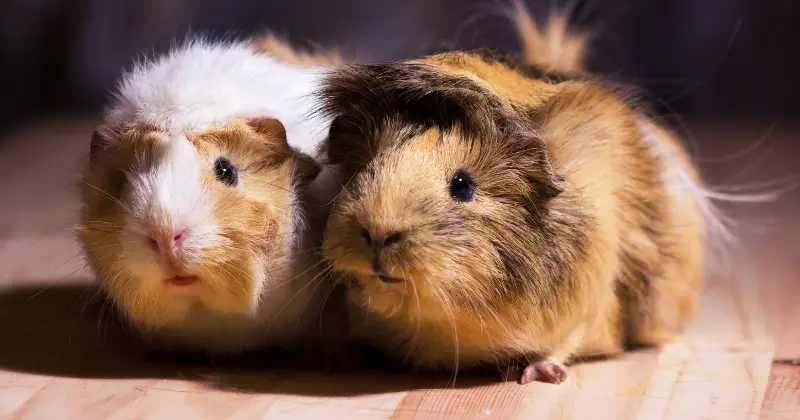
Guinea pigs are social animals that enjoy playing with each other in several ways. One of the most common play behaviors is chasing. They often run around their cage, chasing each other in a friendly manner, showing fondness and companionship.
Another playful interaction is humping. While this may look odd to some, it’s quite normal for guinea pigs and is usually a form of dominance. This behavior can be seen more frequently between males or during introductions between new guinea pigs. Females may also hump their cage mates when they’re in heat.
Wrestling and climbing on one another can also be a part of guinea pig playtime. They may be seen pushing each other around or trying to climb on top of each other gently, which is perfectly normal and harmless. However, if it escalates to biting or lunging with hostile intent, that could be a sign of fighting rather than playing.
Guinea pigs also enjoy popcorning, which is a unique hopping motion they perform when they’re excited or happy. It involves the guinea pig hopping in the air while twisting their body and is quite an adorable sight to see.
Purring and rumbling are other common noises guinea pigs make during playtime. A low-frequency purr can signal contentment and happiness while they are playing, whereas a rumble is typically used to establish dominance or attract a mate.
In summary, guinea pigs engage in various playful behaviors like chasing, humping, wrestling, climbing on one another, popcorning, purring, and rumbling. These activities are essential for their mental and physical well-being and help promote bonding between guinea pigs.
Social Interactions and Bonding

Guinea pigs are casual social animals that enjoy spending time with their fellow creatures. They express their playful nature through various interactions, forming close relationships with one another. Some of the main ways guinea pigs engage with each other include mounting, sniffing, nudging, grooming, and cuddling.
As mentioned in Own Your Pet, guinea pigs may chase each other around the cage, demonstrating their fondness and growing companionship. They can play this way for hours, looking totally adorable while they do it.
Mounting, or humping, while it may seem inappropriate, is actually a normal part of guinea pig play. It doesn’t always have a sexual connotation; it can merely be a way to establish hierarchy within their social group or to bond with their partners.
Nudging is another common interaction between guinea pigs, as it is a way for them to communicate with one another. They use these gentle bumps to express camaraderie, playfulness, and even affectionate grooming.
Sniffing and grooming are essential aspects of guinea pig bonding. When guinea pigs sniff and groom each other, it signifies their mutual trust, love, and respect. Adult guinea pigs mostly communicate their happiness, upset, or desire to mate through these actions, showing the importance of these interactions within their relationships.
Lastly, cuddling is an intimate and comforting way for guinea pigs to bond with one another. Snuggling up close, they derive warmth, safety, and companionship from each other, further strengthening their already tight-knit connection.
These social animals display unique and engaging behaviors when interacting with each other, underlining their strong bonds and shared trust.
Signs of Dominance and Aggression
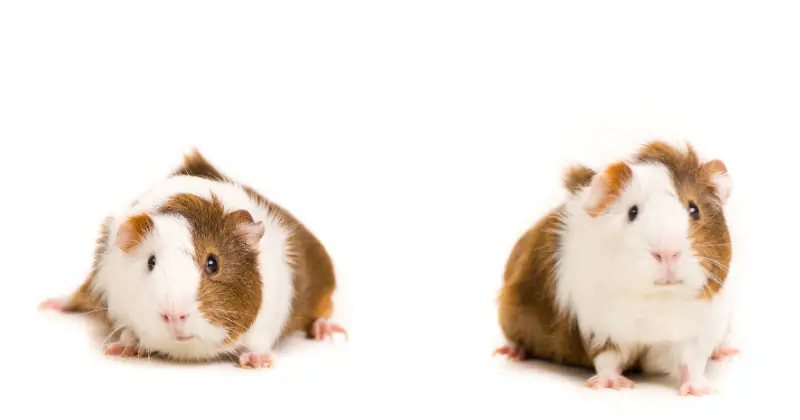
Guinea pigs establish a hierarchy among themselves, and this can lead to displays of dominance and aggression. Recognizing these behaviors is essential to ensure your guinea pigs aren’t hurting each other and living harmoniously.
One common sign of dominance is when a guinea pig rears up on their hind legs. This posture indicates they’re trying to assert their position within the group. Another sign of dominant behavior is raised hackles, which is when the guinea pig’s fur stands up, making it appear larger and more intimidating.
Aggressive behavior, on the other hand, can be identified through actions like biting. Biting, as opposed to gentle nips, demonstrates hostility between guinea pigs. Keep an eye on any excessive or hard bites, as these could indicate aggression.
Teeth chattering or loud growling is another major sign of aggression. When guinea pigs feel threatened or annoyed, they might chatter their teeth or growl to warn other guinea pigs to back off.
Guinea pigs may also start circling each other when attempting to establish dominance or if they become aggressive. Additionally, they might lunge at each other, which can escalate into a full-fledged fight.
While playing and chasing each other can be a normal part of guinea pig interaction, these behaviors can become aggressive if they escalate or show signs of hostility. Keep an eye on your guinea pigs and monitor their behavior to ensure they’re engaging in healthy and harmless play.
Creating a Playful Environment

It’s important to provide a playful environment for your guinea pigs, as they love playing with each other and enjoy exploring their surroundings. You can start by giving them enough space in their cage to do this. A spacious environment will allow them to move around freely, chase and follow each other, and indulge in various activities.
Toys are a great addition to any guinea pig’s environment. Providing them with items like climbing structures, chew toys, and various textures to explore will stimulate their natural curiosity. Remember to switch up the toys to keep their interest occasionally.
Hay should be an essential component in their cage, not just for dietary purposes but also for their playtime. They love to burrow and hide in hay, and it offers them a chance to forage and exercise their chewing instincts.
Another crucial aspect of creating a playful environment is offering ample hiding spots. Guinea pigs are naturally timid and require an area where they can retreat to feel safe. You can use store-bought hides or create your own with cardboard boxes – just ensure they have more than one option.
Encourage their love for exploring by including tunnels and burrows in their living area. Tunnels can be made from a variety of materials, like PVC pipes or large cardboard tubes. You can even design your own cardboard box maze, giving them something new and exciting to navigate.
Lastly, don’t forget the importance of exercise to keep your guinea pigs healthy and happy. Providing them with opportunities to stretch, run, and jump is essential. You can create these opportunities by arranging their toys, tunnels, and hiding spots to promote movement and activity.
By focusing on these elements, you’ll create an engaging and entertaining space that encourages your guinea pigs to play with each other, keeping them active and content in their environment.
Introducing New Guinea Pigs
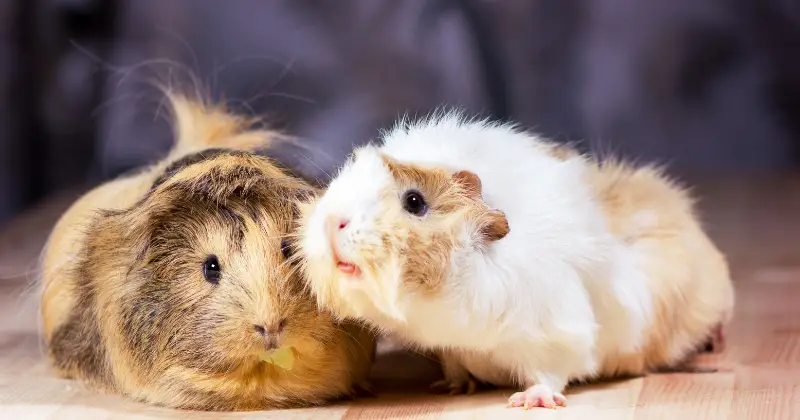
Introducing new guinea pigs to each other is essential for their social well-being. As sociable creatures, they thrive when living in pairs or small groups. Whether you have a boar (male) or sow (female), making the introduction process as smooth and stress-free as possible is important.
To start, make sure the new guinea pig is healthy and not pregnant. This can be done by isolating them for a brief period to monitor their condition. Once you’re certain of their health, let the guinea pigs sniff each other to get familiar with each other’s scent. This helps them become more comfortable in each other’s presence.
Next, choose a neutral area for your pets to meet. This allows them to freely explore and familiarize themselves with each other without territorial issues. Keep a close eye on their interactions during this time to ensure they are getting along fine. Light chasing, humping, and sniffing are all normal parts of guinea pigs’ social behavior.
However, if you notice any biting, lunging, or actions leading to bloodshed, separate them, as this is a sign of fighting.
As they adjust to their new companion, ensure they have enough space to share food, water, and play areas comfortably. A comfortable environment allows them to express their social behavior, ultimately leading to a strong bond.
Remember, patience and gradual progress are key when introducing new guinea pigs. By following these steps, you’ll soon have happy and playful pets enjoying each other’s company in no time.
Communication and Body Language
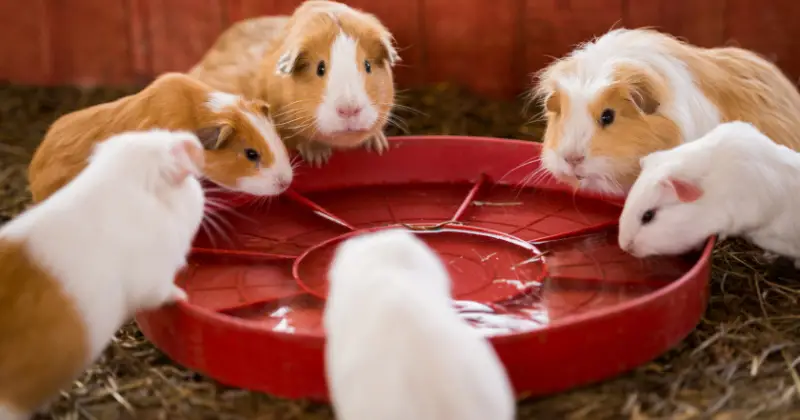
Guinea pigs are social animals, and they use a variety of vocalizations and body language to communicate with each other during playtime. Understanding their communication can help you create a harmonious environment for them.
One common sound guinea pigs make during play is squeaking or chirruping. This often signifies excitement, anticipation, or curiosity when they are interacting with each other. Sometimes, they might emit more high-pitched squeaks, known as shrieks, when they feel threatened or frightened.
It’s important to differentiate between these two sounds to ensure your guinea pigs are happily playing together and not stressed.
In terms of body language, popcorning is a playful action that looks like a small hop or jump. This joyful behavior typically happens when guinea pigs are feeling particularly content or excited during playtime.
When guinea pigs play with each other, they might also engage in nose touching, a sign of greeting and indicating they want to interact with each other. On the other hand, mounting is a display of dominance, and it’s common to see this behavior between two guinea pigs during play. Just be mindful to ensure this doesn’t escalate into aggression.
Lastly, keep an eye out for signs of heat in female guinea pigs. When in heat, they may display noticeable changes in their behavior and communication. For example, they might emit a low rumbling sound, called a rumble strut, while moving their hips and flattening their ears. Be attentive to these behaviors to avoid any stress or discomfort in your guinea pigs.
By paying close attention to their sounds and body language, you can better understand the ways in which guinea pigs play and communicate with each other. This knowledge will help you provide your little furry friends a safe and enjoyable environment.
How to Introduce and Bond Guinea Pigs! Watch this
DIY Toys and Enrichment Ideas
Guinea pigs are sociable and playful creatures, always on the lookout for new ways to entertain themselves and each other. Providing a variety of DIY toys and stimulating activities can keep them happy, healthy, and mentally engaged. Here are a few simple ideas to spark their curiosity and foster bonding between your pint-sized pals.
Cardboard is a versatile and budget-friendly material for creating various guinea pig toys. You can easily make tunnels, mazes, or hiding spots by cutting and connecting old boxes. Alternatively, repurpose toilet paper tubes by stuffing them with hay, small twigs, or newspaper. Watch your pigs explore their new toys, rustling around, chewing, and dragging them while having a blast!
Vegetables can also be turned into exciting playthings for your furballs. One fun and nutritious option is to take a bell pepper, cut a hole in it, stuff some guinea pig safe food inside, and then hang it from the top of the cage. Expect a delightful and likely contagious reaction from your pets as they figure out how to get the tasty treats hidden within.
For guinea pigs who are shy or less energetic, providing opportunities for digging and hiding can help them gain confidence and engage in play. Use safe, non-toxic materials such as shredded paper, fleece strips or soft hay for them to burrow into. Creating mini-digging pits within their habitat can encourage natural, instinctive behavior while providing some much-needed mental stimulation.
Puzzles and creative challenges keep the guinea pigs’ minds sharp and encourage them to explore new things. Recycle a cardboard egg carton and fill the compartments with their favorite treats, like small fruit pieces or pellets. They’ll be on an exciting hunt, pushing the carton around to uncover the tasty surprise you’ve stashed away!
Lastly, considering that guinea pigs are heavy chewers, items they feel inclined to nibble on are vital for maintaining their dental health. Providing them with an assortment of safe wood branches, non-toxic chew toys or even stuffed socks filled with hay can help satisfy their innate need for chewing while keeping them amused.
Introducing a mix of DIY toys and stimulating activities’ll keep your guinea pigs entertained and ensure their well-being, making playtime a joyful and engaging experience for all involved.
How to Handle Conflict and Overly Aggressive Behavior
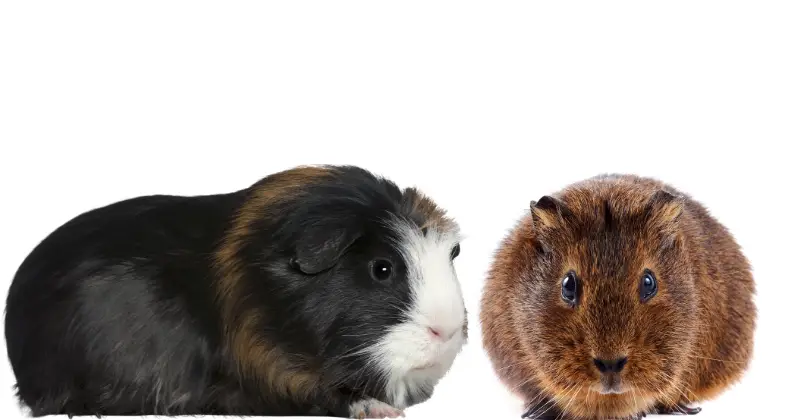
Guinea pigs are social animals who enjoy playing with each other. However, sometimes they can display aggressive behaviors like chasing, attacking, or fighting. Knowing how to handle these situations is important to keep your guinea pigs safe and happy.
First and foremost, it’s essential to identify when guinea pigs are actually fighting or being aggressive, as sometimes they might just be engaged in a dominant or playful chase. Pay close attention to their behaviors and listen for loud squeaking, teeth chattering, or other signs that might indicate aggression.
If you notice that your guinea pigs are displaying overly aggressive behavior or fighting, separating them as soon as possible is crucial. Never use your bare hands to do this, as it can result in scratches and bites. Instead, consider using a towel to gently wrap around the guinea pig and carefully move them to a separate area.
Monitor your guinea pigs closely during and after any conflict to ensure their safety. If your guinea pigs are repeatedly engaged in aggressive behaviors, it may be a good idea to provide them with separate living spaces to avoid any severe injuries or further issues.
When introducing new guinea pigs to one another, take it slow and give them time to adjust. This can help minimize the possibility of aggression and help establish a peaceful coexistence.
In conclusion, handling conflict and overly aggressive behavior among guinea pigs requires vigilance, patience, and proper intervention. Keep an eye on your pets and take action whenever necessary to ensure they stay safe and stress-free.
Keeping Your Guinea Pigs Happy and Healthy
One of the best ways to keep your guinea pigs happy is by providing them with a variety of healthy food options. Hay, fresh vegetables, pellets, and clean water are essential components of their daily diet. Ensure that the food you provide is suitable for their age and breed, and always provide fresh water to stay hydrated.
Regular socialization and enrichment activities are also important for guinea pigs to stay happy. Try giving them toys or creating a play area where they can explore, climb, and hide. Providing various types of treats can also bring joy to your guinea pigs and contribute to their overall mental well-being. Remember to monitor their treats intake and ensure it remains in moderation to maintain their health.
Keeping their living environment clean and hygienic is essential, as this greatly contributes to their overall health. Make sure to clean the cage regularly and provide ample bedding material to ensure their comfort. A tidy living space will also help prevent illnesses and infections.
Observing your guinea pigs’ behavior is crucial in assessing their happiness and health. Keep an eye out for any changes in their routine or unusual behavior that could indicate stress or illness. Promptly addressing these issues can go a long way in ensuring that your guinea pigs remain happy and healthy.
Finally, maintaining a consistent feeding, playing, and cleaning routine will help your guinea pigs feel secure and content. Following these tips can create a nurturing environment where your guinea pigs can thrive and experience optimal well-being.
Guinea Pigs and Other Pets
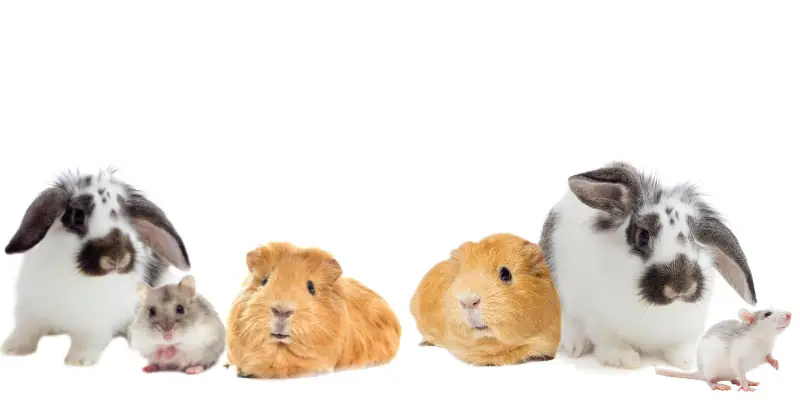
Guinea pigs are social animals that often enjoy the company of other guinea pigs. But, when it comes to introducing them to various other pets, there are a few things to consider. This can ensure the safety and well-being of both your cavy and other household animals.
If you have kids or children in the house, teaching them about proper guinea pig handling and care is essential. Their gentle and friendly nature makes guinea pigs an ideal pet for children. Show your child how to be gentle and interact calmly, as guinea pigs can be startled easily by sudden movements or loud noises.
It depends on the dog’s breed and temperament when considering dogs and guinea pigs. Some dog breeds, like terriers, have a strong hunting instinct and may not be the best match for a guinea pig. On the other hand, some dogs can coexist peacefully with cavies as long as the dog is well-socialized and supervised during interactions.
Similarly, cats can also pose a risk to guinea pigs. Some cats view smaller animals as prey; their hunting instincts could kick in. It’s important to monitor any interaction between your cat and guinea pig closely, ensuring the cat is calm and doesn’t become too interested in the cavy. Providing a safe, enclosed space for your guinea pig can also help protect them from curious cats.
In conclusion, guinea pigs can be a great addition to a family with other pets as long as proper precautions are taken. Monitor all interactions closely and provide a secure space for your guinea pig to retreat to when they need some alone time.
Recognizing Unhappiness and Depression
Guinea pigs are social animals that enjoy playing with each other and engaging in various activities. It’s essential to keep an eye on their behavior to ensure they are happy and healthy. When guinea pigs are unhappy or depressed, there can be noticeable changes in their actions.
One common sign of an unhappy or depressed guinea pig is increased hiding and spending more time in their hiding places. They may also sleep a lot and show reluctance to eat, play, or socialize with their fellow guineas.
These signs can indicate that they are not getting enough stimulation or social interaction in their environment. Ensure to provide ample opportunities for climbing, running around, and exploring – you can use items like toilet paper tubes to keep them entertained.
In the realm of physical communication, guinea pigs sometimes display aggressive behavior, such as nipping or fur pulling, when feeling depressed. Paying attention to these cues is important as they can escalate if the guinea pig’s needs are unmet. Providing a bigger cage and more hiding places can help alleviate tension and reduce the likelihood of further aggression.
Another sign of unhappiness in guinea pigs is a change in their vocalizations, such as purring. While purring can sometimes be a signal of contentment, it can also signify discomfort or anxiety if accompanied by other behavioral changes like hiding or aggression. Make sure to monitor your guinea pigs’ vocalizations to gauge their mood appropriately.
Keeping your guinea pigs happy and engaged is crucial for their well-being. By understanding their behavior and providing a stimulating environment, you can ensure that your furry friends lead healthy and fulfilling lives.
What are some important considerations for guinea pig owners regarding aggressive behaviors, territoriality, and bonding behaviors?
Guinea pig owners should be aware of the potential risks associated with aggressive teeth and hostile intent, taking immediate action to address any harmful behaviors. It is worth noting that guinea pigs may exhibit territorial behavior, which can be managed by ensuring sufficient cage sizes and creating a balanced distribution of resources. Bonding behaviors, such as grooming and physical contact, are positive signs of a strong bond between guinea pigs.
Conclusion: How Do Guinea Pigs Play With Each Other

In conclusion, when understanding how they play with each other, it is important to consider behaviors in guinea pigs, such as fighting behaviors, normal behavior, signs of aggression, and dominant behavior. Female guinea pigs, guinea pig owners, and their individual personalities play significant roles in establishing a positive social hierarchy and minimizing aggressive displays.
Providing a calm environment, sufficient cage space, and mental and physical stimulation opportunities can contribute to a harmonious interaction between guinea pigs. Guinea pig owners can ensure a safe and enjoyable play experience for their furry friends by being attentive to their body language and addressing any territorial issues.
Additionally, it is crucial to create a neutral space for initial introductions between guinea pigs, especially if they come from separate cages. Monitoring their interactions and intervening if necessary can prevent full-blown fights and potential injuries.
Understanding the natural behavior of guinea pigs as prey animals helps us recognize the significance of social hierarchies and dominance behaviors within a group. Providing adequate resources such as food bowls and maintaining a calm environment can promote peaceful coexistence among guinea pigs.
In conclusion, observing and interpreting guinea pigs’ body language, understanding their needs for space, mental stimulation, social interactions, and proper handling and care contribute to their overall well-being. By fostering a positive and enriching environment, guinea pig owners can nurture strong bonds and foster a sense of companionship among their furry companions.


